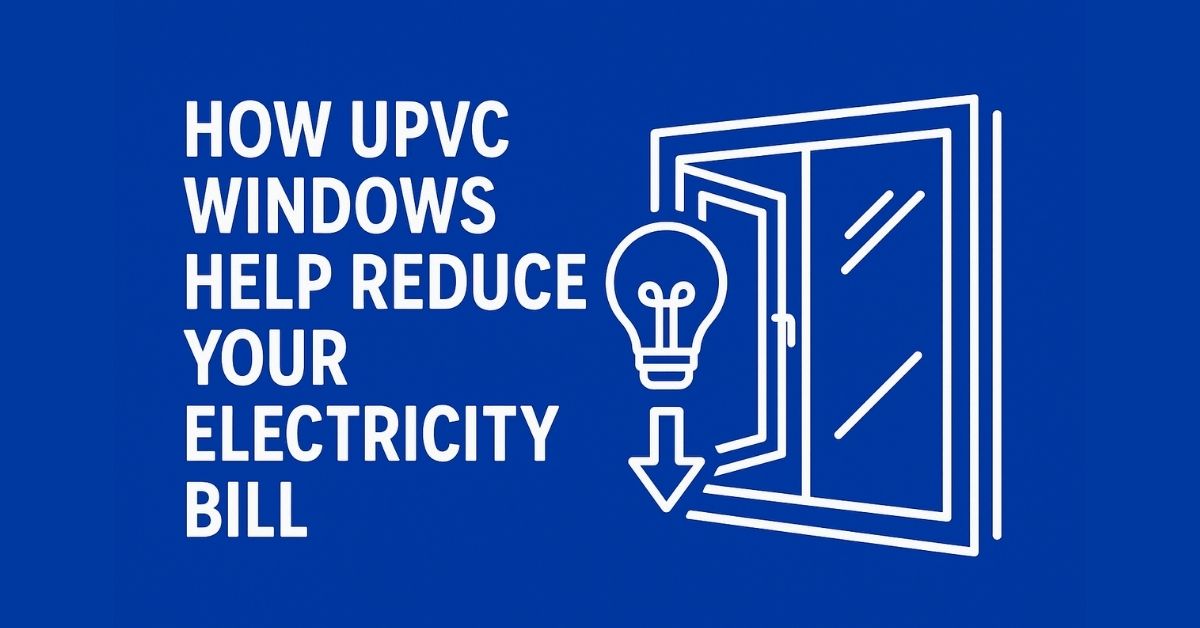In today’s world of rising energy costs, homeowners are constantly looking for smart ways to cut down on electricity bills. While switching off unnecessary lights and using energy-efficient appliances helps, one of the most overlooked solutions is right in front of us—our windows.
Windows play a huge role in regulating indoor temperature. Poorly insulated windows allow heat to escape during winters and let it in during summers, forcing your AC or heater to work overtime. That’s where UPVC windows come in—an affordable and long-lasting way to reduce your energy consumption.
What Are UPVC Windows?
UPVC stands for Unplasticized Polyvinyl Chloride. It’s a highly durable, low-maintenance material commonly used in modern window and door frames. Unlike wood or aluminum, UPVC doesn’t warp, rot, or conduct heat, making it ideal for insulation.
These windows are built with multi-chambered frames and can be combined with double or triple glazing to offer superior thermal performance. Whether you live in a hot or cold climate, UPVC windows act as a thermal barrier—keeping the indoor temperature stable and reducing the load on your HVAC system.
The Science Behind Energy Loss Through Windows
Windows are one of the biggest culprits when it comes to heat loss or gain in a home. In summer, sunlight and hot air seep through inefficient windows, making your air conditioner work harder. In winter, the warmth inside escapes through the same weak points, forcing your heater to run longer.
This process is known as thermal transfer—the movement of heat from warmer to cooler areas. Traditional window materials like aluminum are good conductors of heat, which means they allow this transfer easily. Poor sealing or single-glass panes make the problem worse by letting air leak in or out.
In contrast, well-insulated windows help break this cycle—reducing energy consumption and ultimately lowering your bills.
How UPVC Windows Improve Energy Efficiency

UPVC windows are designed specifically to fight heat transfer and air leakage. Here’s how they help:
- Multi-Chambered Design: The internal structure of UPVC frames includes multiple air chambers that act as insulation layers, slowing down heat transfer.
- Glazing Options: UPVC frames easily accommodate double or triple glazing, which traps air (or inert gases like argon) between the glass layers to minimize temperature change.
- Tight Sealing: These windows are built with precision sealing technology that blocks drafts and prevents conditioned air from escaping.
- Low Thermal Conductivity: Unlike metal frames, UPVC does not absorb or transfer heat, helping to maintain a steady indoor temperature.
The result? Your air conditioner or heater runs less often, saving you money month after month.
Real-World Benefits
Switching to UPVC windows can make a noticeable difference in your home’s comfort and your monthly electricity bill. Here’s how:
- Reduced Energy Consumption: With better insulation, your AC and heater don’t have to work as hard, cutting down electricity usage.
- Consistent Indoor Temperature: UPVC windows help maintain a stable, comfortable temperature inside—no hot spots in summer or cold drafts in winter.
- Savings Over Time: Though the upfront cost may be higher than regular windows, the energy savings pay off within a few years.
Comparison Table: Energy Performance
| Feature | Traditional Windows | UPVC Windows (Double Glazed) |
|---|---|---|
| Thermal Insulation | Poor | Excellent |
| Air Leakage Protection | Low | High |
| Energy Bill Impact | Higher costs | Up to 30–40% savings |
| Maintenance Needs | Frequent | Minimal |
| Noise Insulation | Low | High |
These numbers reflect general trends and may vary based on your home’s design and climate. Still, the takeaway is clear—UPVC windows are a strong investment for long-term savings.
Bonus Perks
Besides lowering your energy bills, UPVC windows offer several additional advantages:
- Noise Reduction: Perfect for urban areas, the tight seals and glazing reduce outside noise.
- Low Maintenance: No painting, no polishing—just occasional cleaning with water and mild soap.
- Weather Resistance: Resistant to rain, humidity, and harsh sun—ideal for Pakistan’s changing weather.
- Eco-Friendly: UPVC is recyclable and supports sustainable building practices.
These benefits make UPVC windows not only smart for your wallet, but also for your lifestyle and the environment.
Cost vs. Savings
Some homeowners hesitate to invest in UPVC windows because of the higher upfront cost compared to traditional aluminum or wooden frames. But here’s the reality: UPVC pays for itself over time through energy savings, durability, and zero maintenance costs.
Let’s break it down:
Estimated 5-Year Cost Comparison
| Expense Category | Traditional Windows | UPVC Windows |
|---|---|---|
| Initial Cost | Lower | Moderate |
| Maintenance (5 years) | High (repainting, repairs) | None to minimal |
| Energy Bills | High (inefficient) | Reduced by 30–40% |
| Total 5-Year Spend | High | Lower overall |
Even though the initial investment is higher, the long-term savings and convenience make UPVC windows a financially smart choice. Plus, the added comfort and noise insulation are a bonus.
Conclusion
UPVC windows are more than just a stylish upgrade—they’re a long-term solution for energy efficiency, cost savings, and a better living experience. By reducing heat transfer and blocking air leaks, they help you cut electricity bills while staying comfortable in every season.
If you're looking to reduce your energy bills, enhance your home’s value, and future-proof your space, UPVC windows from Skizo are the way to go.
